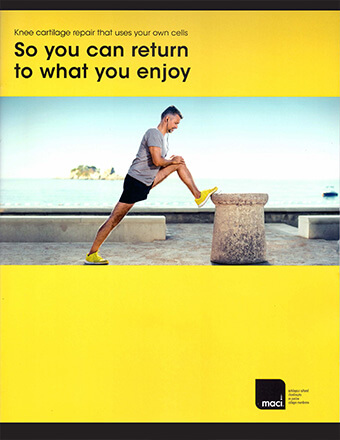For more information about MACI
MACI procedure
Matrix-induced autologous chondrocyte implantation
Your knee is a complex joint where three major bones come together: the shin bone (tibia), the thigh bone (femur), and the knee cap (patella). Ligaments and cartilage connect and protect these bones at the knee joint.
Cartilage is a strong, rubbery and key connective tissue found in many parts of the body, including joints. The two types of cartilage found in the knee are the meniscus, which acts as a cushion between the bones, and the articular cartilage which covers the ends of the bones to ensure smooth movement.
Articular cartilage can be damaged many ways. Chronic or repetitive actions from exercise, sports, or physical work can cause cartilage to weaken and wear out with time.
Acute or traumatic events such as a fall can cause immediate and severe cartilage damage.
Symptoms of knee injuries:
- Pain
- Swelling
- Clicking
- Locking
Unfortunately, cartilage does not heal on its own. Unlike other tissues, cartilage does not repair itself. Cartilage injuries are chronic and often get worse as time goes on. If conservative treatment has not worked to relieve pain, surgery is the next step.
About
MACI procedure creates a repair tissue that allows patients to resume an active lifestyle.
- Functional repair tissue – MACI produces a type of repair tissue that alleviates symptoms and restores joint function which has been shown to form as early as 6 months after the procedure.
- Reduced pain and improved function – In clinical trails, MACI offered greater pain relief and improvement in function when compared to microfracture.
- Patient satisfaction – MACI patients reported higher quality of life scores, a greater ability to perform recreational and sports activities, and improved overall knee function.
Here’s how the MACI process works
Once the doctor decides that surgical intervention is necessary, the patient comes in for a quick knee scope to assess the damage. If the patient has a large articular cartilage defect, a small biopsy of the cartilage tissue is sent to the Vericel labs in Cambridge, MA. Over the next 1-2 months, the cells are grown and multiplied, then placed on a membrane ready to implantation. The surgeon implants the membrane seeded with the patient’s cells. After surgery, the cells will continue to grow and solidify, filling the cartilage void for the patient and leaving them with a new cartilage surface, restoring function and alleviating pain.
The first MACI articulated cartilage transplant in Tampa Bay
Dr. Seth Gasser performed the first MACI articulated cartilage transplant ever to be done in the Tampa Bay area in 2017 at the Florida Orthopaedic Institute Surgery Center. “We can treat a variety of different patients with MACI,” said Dr. Gasser of Florida Orthopaedic Institute. “It may be a parent who is experiencing severe knee pain while performing simple tasks around the house such as walking up the stairs or doing yard work. MACI can also be used to treat higher demand patients such as athletes, firefighters, law enforcement professionals, and active military personnel.” Florida Orthopaedic Institute was the first location in the Tampa Bay area to perform the MACI procedure.
To find out if MACI is right for you, contact one of these Florida Orthopaedic Institute surgeons certified in MACI and specialize in this procedure.

Treatment
The fellowship trained surgeons at Florida Orthopaedic Institute use several surgical techniques for treating damaged knee cartilage.
Chondroplasty
Also called debridement and lavage. Damaged cartilage is trimmed off, and then the area is cleansed with sterile water. Chondroplasty may offer temporary relief but does not repair the cartilage.
Marrow stimulation
Such as microfracture, abrasion arthroplasty, and subchondral drilling. Small holes are drilled into the bone allowing blood and bone marrow cells to seep out creating a blood clot that forms repair tissue. The surgical techniques form a tissue that is closer to fibrocartilage rather than the more durable hyaline cartilage found in normal articular cartilage.
Osteochondral implants
Autologous or Allograft. Healthy pieces of both cartilage and bone are placed into damaged areas, using a patient’s own tissue (osteochondral autograft, also called OATS®) or tissue from a cadaver (osteochondral allograft).
Autologous chondrocyte implantation (ACI)
A biologic procedure uses a patient’s own cartilage cells in a lab to grow additional cells, which are implanted in the damaged area. The new tissue has properties similar to hyaline cartilage, the durable tissue found in articular cartilage.
Used for more than 20 years, ACI has been proven to provide long-lasting pain relief and to help patients regain knee function. MACI® is a third generation ACI, offering a safer way to deliver cells. MACI repairs deep cartilage damage of the adult knee.
MACI (autologous cultured chondrocytes on porcine collagen membrane) is made up of a patient’s own (autologous) cells. They are grown in a laboratory and placed onto film which is implanted into the area where the damaged cartilage was removed. The film is absorbed back into the body.
Related specialties
- ACL Injuries
- Arthroscopic Chondroplasty
- Articular Cartilage Restoration
- Deep Thigh Bruising
- Fractures of the Tibial Spine
- Iliotibial Band Syndrome
- Lateral Collateral Ligament (LCL) Injuries
- Medial Collateral Ligament Injuries
- Meniscus Tears
- Muscle Spasms
- Muscle Strains of the Calf
- Partial Knee Replacement
- Patellar Fracture
- Quadriceps Tendon Tear
- Runner's Knee
- Senior Strong
- Shin Splints
- Total Knee Replacement Surgery

